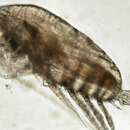Comprehensive Description
provided by Smithsonian Contributions to Zoology
Paracalanus indicus Wolfenden
Paracalanus parvus (Claus).—Giesbrecht, 1892:164–199, pls. 1, 6, 9.—Sewell, 1929:68–71, figs. 24–25.
Paracalanus parvus var. indicus Wolfenden, 1905:998, pl. 96: figs. 7, 9–11.
DIAGNOSIS.—Female. Body more slender and slightly shorter than P. quasimodo, length about 0.9 mm. Prosome about 3.2 times as long as urosome; dorsal hump only slightly or not at all developed, hence prosome not so high in relation to its length as in P. indicus. Forehead not vaulted. Genital segment, viewed dorsally, narrower than in P. quasimodo, lateral parts of posterior margin with row of minute spinules, without cluster of spinules above spermatheca. Spermatheca subelliptical, not narrowing distally.
Antenna 1 reaching about to posterior margin of anal segment. Armature of legs very similar to that of P. quasimodo but slightly less strongly developed.
Male. Identical to P. quasimodo except for the lack of spinules on the genital segment.
The Gill specimens are very similar to and perhaps conspecific with specimens from the Gulf of Naples collected for the Smithsonian Institution by Dr. L. S. Kornicker; a few illustrations of Dr. Kornicker’s specimens are given for comparison (Figures 22k–l).
Wolfenden (1905) proposed his varieties borealis and indicus after comparing specimens from the Indian Ocean (Maldive Archipelago) and the Faroe Channel with each other and with the descriptions and illustrations of Sars (1901, Norwegian specimens) and those of Giesbrecht (1892) and Scott (1894) from the Gulf of Naples and Gulf of Guinea respectively. If further study should show that the Indian Ocean and Mediterranean-Atlantic forms that Wolfenden considered identical are specifically distinct, the specific name indicus must be restricted to the Indian Ocean form. My use of the name indicus for the Gill species is tentative.
- bibliographic citation
- Bowman, Thomas E. 1971. "The distribution of calanoid copepods off the Southeastern United States between Cape Hatteras and southern Florida." Smithsonian Contributions to Zoology. 1-58. https://doi.org/10.5479/si.00810282.96

